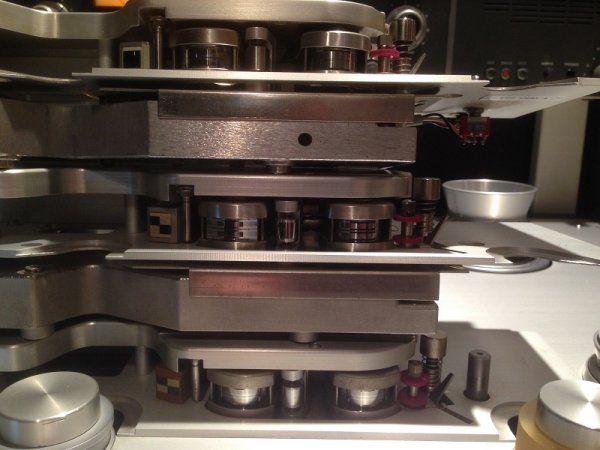Hi
Has anyone ever conducted a comparison between tapes with machines with same heads and pre-amp ( the electronics in the tape , correct me for the term pre-amp if needs be). I sincerely believe for the most part we are not discussing the same things if the heads and electronics are different. I am also with Christian on his contention that vibration affect RTR much less than TT ... On that same with TT BTW. Inferences of a table being superior (or inferior) when cartridges , arms and even position in the room are different...
the issues here are;
chassis -> tape path -> heads -> output electronics (tape repro preamp).
there are 'non-standard' high resolution heads.
tape path includes reel hubs, guides, lifters, rollers, etc.
output electronics can be the (1) internal stock output electronics, (2) some sort of factory option such as the 'trafoless' cards in my 1/2" Studer which are a factory option which eliminates the output transformer of the stock Studer output electronics, (3) modified internal electronics (UHA, de Paravicini) and (4) custom outboard output electronics such as the King-Cello, the various Bottlehead products, the Doshi, the Manley, etc. etc.
regarding fitting the King Cello into my system it took three tries to get the King Cello right for my system from an EQ perspective with the Studer heads and in terms of balance and so it worked with my 'zeel' 50 ohm darTZeel preamp interface. so when I hear about opinions on the King Cello I just roll my eyes. this stuff is not plug and play.
does the EQ of the output electronics work ideally for the EQ of the particular heads? and then does the output of the custom output electronics interface properly with your system preamp?
using custom output electronics introduces the variable of whether you have a switch to choose the internal or custom output signal path or whether it's hard wired, then does the custom output electronics have the ability to adjust to the test tones on the tape? or do you rely on an anticipated narrow band of tape EQ?
and then there is the gain of the tape itself and whether the heads of the deck can handle (take proper advantage) of the choice of tape. typically master recorders (the heads) can handle higher gain tape than consumer/prosumer decks which is a challenge for sellers such as The Tape Project to find the right compromise of gain across the board of users without dumbing down the tapes to the lowest common denominator.
so when you are comparing one deck to another there are lots of variables to consider to figure out what you are comparing......even using the same tape side by side. to get the full picture of where various decks and electronics stand takes some time and experience since there are so many issues. everything is context related.
thankfully since the Tape Project started in 2007 most tapes that are sold are modern formulation and IEC EQ with similar gain settings so adjusting for test tones can be mostly a non-issue unless you have vintage tapes that you are using.
in my particular case I have my opinions about how the 1/4" Studer A-820 standard stock output compares to the Ampex ATR-102 standard stock output, and then how the A820 -> King Cello compares to the stock ATR-102. since I did not have the ATR-102 modified with a direct out switch I never tried it with the King Cello. I did compare both of those machines with both a stock Technics RS-1500 and the de Paravicini modified Technics, as well as with my Nagra T and IV-S. as well as how the Studer A820 1/4" and 1/2" compares both with and without the King Cello. and then I compared how the A-820 sounded with the stock output into my 'old' darTZeel preamp (with has transformers on the XLR inputs) and the new darTZeel preamp which eliminated the transformer on the XLR input and sounds much better and then how that compares to using the King Cello.
I've also tried 4-5 other custom tape output electronics in my system that I did not keep.
and that is just my experience in my own system as to how things seem to work.
so many ways to look at things.


